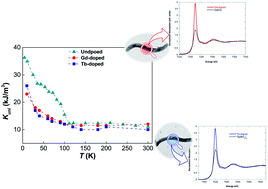Modifying the magnetic response of magnetotactic bacteria: incorporation of Gd and Tb ions into the magnetosome structure†
Abstract
Magnetotactic bacteria Magnetospirillum gryphiswaldense MSR-1 biosynthesise chains of cube–octahedral magnetosomes, which are 40 nm magnetite high quality (Fe3O4) nanoparticles. The magnetic properties of these crystalline magnetite nanoparticles, which can be modified by the addition of other elements into the magnetosome structure (doping), are of prime interest in a plethora of applications, those related to cancer therapy being some of the most promising ones. Although previous studies have focused on transition metal elements, rare earth (RE) elements are very interesting as doping agents, both from a fundamental point of view (e.g. significant differences in ionic sizes) and for the potential applications, especially in biomedicine (e.g. magnetic resonance imaging and luminescence). In this work, we have investigated the impact of Gd and Tb on the magnetic properties of magnetosomes by using different complementary techniques. X-ray diffraction, transmission electron microscopy, and X-ray absorption near edge spectroscopy analyses have revealed that a small amount of RE ions, ∼3–4%, incorporate into the Fe3O4 structure as Gd3+ and Tb3+ ions. The experimental magnetic characterisation has shown a clear Verwey transition for the RE-doped bacteria, located at T ∼ 100 K, which is slightly below the one corresponding to the undoped ones (106 K). However, we report a decrease in the coercivity and remanence of the RE-doped bacteria. Simulations based on the Stoner–Wohlfarth model have allowed us to associate these changes in the magnetic response with a reduction of the magnetocrystalline (KC) and, especially, the uniaxial (Kuni) anisotropies below the Verwey transition. In this way, Kuni reaches a value of 23 and 26 kJ m−3 for the Gd- and Tb-doped bacteria, respectively, whilst a value of 37 kJ m−3 is obtained for the undoped bacteria.

- This article is part of the themed collection: Popular Advances


 Please wait while we load your content...
Please wait while we load your content...